Related Research Articles
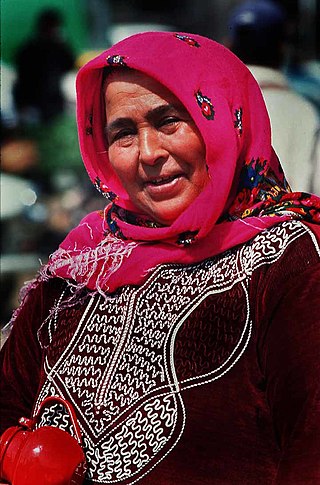
In modern usage, hijab generally refers to variety of head coverings conventionally worn by many religious Muslim women as an expression of faith. Such women may be called "hijabi". Similar to the mitpaḥat/tichel or snood worn by religious married Jewish women, certain headcoverings worn by some Christian women, such as the hanging veil, apostolnik and kapp, and the dupatta favored by many Hindu and Sikh women, the hijab comes in various forms. Often, it specifically describes a scarf that is wrapped around the head, covering the hair, neck, and ears while leaving the face visible. The use of the hijab has grown globally since the 1970s, with many Muslims viewing it as a symbol of modesty and faith; it is also worn as a form of adornment. There is consensus among Islamic religious scholars that covering the head is either required or preferred. In practice, most Muslim women choose to wear it.

Iman Mohamed Abdulmajid, known mononymously as Iman, is a Somali-American model and actress. A muse of the designers Gianni Versace, Thierry Mugler, Calvin Klein, Donna Karan, and Yves Saint Laurent, she is also noted for her philanthropic work. She was married to musician David Bowie from 1992 until his death in 2016.
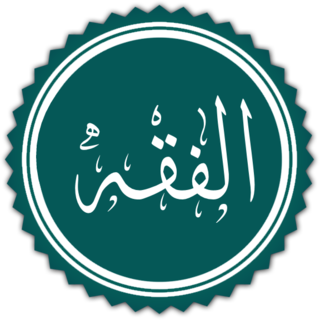
Islamic clothing is clothing that is interpreted as being in accordance with the teachings of Islam. Muslims wear a wide variety of clothing, which is influenced not only by religious considerations, but also by practical, cultural, social, and political factors. In modern times, some Muslims have adopted clothing based on Western traditions, while others wear modern forms of traditional Muslim dress, which over the centuries has typically included long, flowing garments. Besides its practical advantages in the climate of the Middle East, loose-fitting clothing is also generally regarded as conforming to Islamic teachings, which stipulate that body areas which are sexual in nature must be hidden from public view. Traditional dress for Muslim men has typically covered at least the head and the area between the waist and the knees, while women's islamic dress is to conceal the hair and the body from the ankles to the neck. Some Muslim women also cover their face. However, other Muslims believe that the Quran strictly mandate that women need to wear a hijab or a burqa.

The abaya, sometimes also called an aba, is a simple, loose over-garment, essentially a robe-like dress, worn by some women in the Muslim world including most of the Middle East, North Africa, and parts of the Horn of Africa. Traditional abayas are usually black and may either be a large square of fabric draped from the shoulders or head or a long kaftan. The abaya covers the whole body except the head (sometimes), feet, and hands. It can be worn with the niqāb, a face veil covering all but the eyes. Some women also wear long black gloves, so their hands are covered as well. It is common that the abaya be worn on special occasions, such as mosque visits, Islamic holiday celebrations for Eid al-Fitr and Eid al-Adha, and also during the Islamic holy month of Ramadan.

A headscarf is a scarf covering most or all of the top of a person's, usually women's, hair and head, leaving the face uncovered. A headscarf is formed of a triangular cloth or a square cloth folded into a triangle, with which the head is covered.

Islam is the second largest religion in Norway after Christianity. As of 2020, the number of Muslims living in Norway was 182,607. The majority of Muslims in Norway are Sunni, with a significant Shia minority. 55 percent of Muslims in the country live in Oslo and Viken. The vast majority of Muslims have an immigrant background, and very few Norwegians are Muslim.

Iselin Vollen Steiro is a Norwegian model.

In France, there is an ongoing social, political, and legal debate concerning the wearing of the hijab and other forms of Islamic coverings in public. The cultural framework of the controversy can be traced to France's history of colonization in North Africa, but escalated into a significant public debate in 1989 when three girls were suspended from school for refusing to remove their headscarves. That incident, referred to in France as l'affaire du foulard or l'affaire du voile, initially focused the controversy on the wearing of the hijab in French public schools. Because of the wide-ranging social debates caused by the controversy, l'affaire du foulard has been compared to the Dreyfus affair in its impact on French culture.
Hijab and burka controversies in Europe revolve around the variety of headdresses worn by Muslim women, which have become prominent symbols of the presence of Islam in especially Western Europe. In several countries, the adherence to hijab has led to political controversies and proposals for a legal partial or full ban in some or all circumstances. Some countries already have laws banning the wearing of masks in public, which can be applied to veils that conceal the face. Other countries are debating similar legislation, or have more limited prohibitions. Some of them apply only to face-covering clothing such as the burqa, boushiya, or niqab; some apply to any clothing with an Islamic religious symbolism such as the khimar, a type of headscarf. The issue has different names in different countries, and "the veil" or hijab may be used as general terms for the debate, representing more than just the veil itself, or the concept of modesty embodied in Hijab.

Various styles of head coverings, most notably the khimar, hijab, chador, niqab, paranja, yashmak, tudong, shayla, safseri, carşaf, haik, dupatta, boshiya and burqa, are worn by Muslim women around the world, where the practice varies from mandatory to optional or restricted in different majority Muslim and non-Muslim countries.
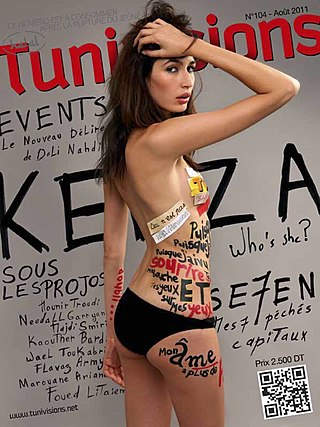
Kenza Fourati is a Tunisian-French model.
Mariah Idrissi is a British model, public speaker, and online personality. Idrissi initially gained recognition as the first Muslim hijab-wearing model when she appeared in multinational retailer, H&M's "Close the Loop" campaign in 2015; after which, Idrissi became a leading authority on "modest fashion" appearing on domestic and international news programmes on the subject. In 2016, Idrissi signed to Select modelling agency in 2016 and signed with Insanity Group Management in 2017.

Islamic Fashion as a phenomenon stemmed from the combination of a set of Islamic practices and of the rising need and desire to include these specific clothing items in a broader fashion industry. The global growth of “an Islamic consumer sector, which explicitly forges links between religiosity and fashion, encouraging Muslims to be both covered and fashionable, modest and beautiful,” is relatively fresh: Islamic Fashion as a particular phenomenon started appearing toward the 1980s.
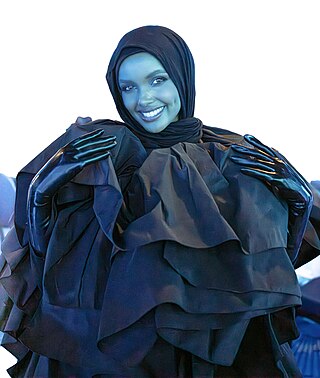
Halima Aden is an American fashion model. She is noted for being the first woman to wear a hijab in the Miss Minnesota USA 2016 pageant, where she was a semi-finalist. Following her participation in the pageant, Halima received national attention and was signed to IMG Models. She was also the first model to wear a hijab and burkini in the Sports Illustrated Swimsuit Issue.
Amena Khan is a British fashion designer, and internet celebrity. She is best known for founding the fashion company Pearl Daisy, designing head scarfs, and becoming the first hijab model in a L'Oreal hair-care campaign.
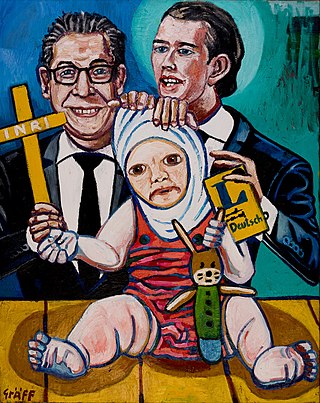
Hijabophobia is a type of religious and cultural discrimination against Muslim women who wear the hijab. The discrimination has had manifestations in public, working and educational places.
Hoda Katebi is an American writer and activist whose work focuses on garment workers' rights, labor in fashion supply chains, Muslim identity, politics and clothing in Iran, and fighting surveillance programs and militarism. She is the founder of Blue Tin Production, the first apparel manufacturing worker co-operative in the United States entirely run by working-class women of color.
Ugbad Abdi is a Somali-American fashion model. Born in Somalia and raised in a Kenyan refugee camp and Des Moines, Iowa, she debuted as a Valentino haute couture model, then opened shows for Marc Jacobs and Michael Kors at New York Fashion Week. She is the first model to walk shows for Fendi and Lanvin while wearing hijab.
Fashion in Iran has a cultural and economic impact on the county of Iran. During the Pahlavi era around the mid-1930s, Western fashion was introduced to the country and greatly influenced women's style. After the Iranian Revolution in 1978–1979, the hijab has become compulsory, which impacted the creation of clothing style.

The burqa is worn by women in various countries. Some countries have banned it in government offices, schools, or in public places and streets.
References
- ↑ "Street Style Star Rawdah Mohamed is the Somali Muslim Model You Need to Follow". V Magazine. 29 August 2019. Retrieved 27 April 2021.
- ↑ Mohamed, Rawdah (22 April 2021). "Model Rawdah Mohamed On Using Social Media to Challenge France's Proposed Hijab Ban". Harper's BAZAAR. Retrieved 27 April 2021.
- ↑ "Online criticism grows over French proposal to ban hijab for children". euronews. 12 April 2021. Retrieved 27 April 2021.
- ↑ Kell, Laura (5 April 2021). "Muslim Content Creators Share Their Own Stories of Islamophobia and Racism". www.harpersbazaararabia.com.
- ↑ "Login • Instagram". www.instagram.com. Retrieved 30 March 2023.
{{cite web}}: Cite uses generic title (help) - ↑ Newbold, Alice (15 June 2020). ""We Need More Space To Be Open": Somalian Model Rawdah On Speaking Out For Those Who Can't". British Vogue. Retrieved 27 April 2021.
- 1 2 "Model Rawdah Mohamed looks majestic in Lebanese look". Arab News. 10 November 2019. Retrieved 27 April 2021.
- ↑ Acielle (15 August 2018). "The Best Street Style at Oslo Fashion Week Spring 2019". Vogue. Retrieved 27 April 2021.
- ↑ Borrelli-Persson, Laird (21 March 2019). "How Rawdah Mohamed Is Challenging Modest Style Conventions and Fashion's Inclusivity Problem". Vogue. Retrieved 27 April 2021.
- 1 2 "Model's 'hands off my hijab' post sparks protest over France's proposed ban". the Guardian. 25 April 2021. Retrieved 27 April 2021.
- 1 2 "'Law against Islam': French vote in favour of hijab ban condemned". www.aljazeera.com. Retrieved 27 April 2021.
- ↑ Yeung, Peter. "The Somali-Norwegian model campaigning for Muslim women's rights". www.aljazeera.com. Retrieved 1 June 2021.
- ↑ "Model behind 'hands off my hijab' post named editor of 'Vogue Scandinavia'". The National. 29 May 2021. Retrieved 1 June 2021.
- ↑ "Model behind 'hands off my hijab' post is named Vogue Scandinavia editor". the Guardian. 27 May 2021. Retrieved 1 June 2021.
- ↑ Philip Haglund, ed. (9 September 2022). "Raser etter dronningens død: – Håper du brenner i helvete" [Fuming following the death of the Queen: - Hope you burn in hell] (in Norwegian). Nettavisen . Retrieved 11 September 2022.